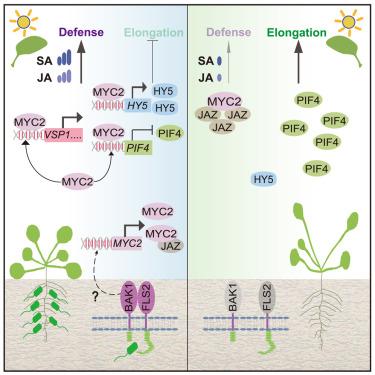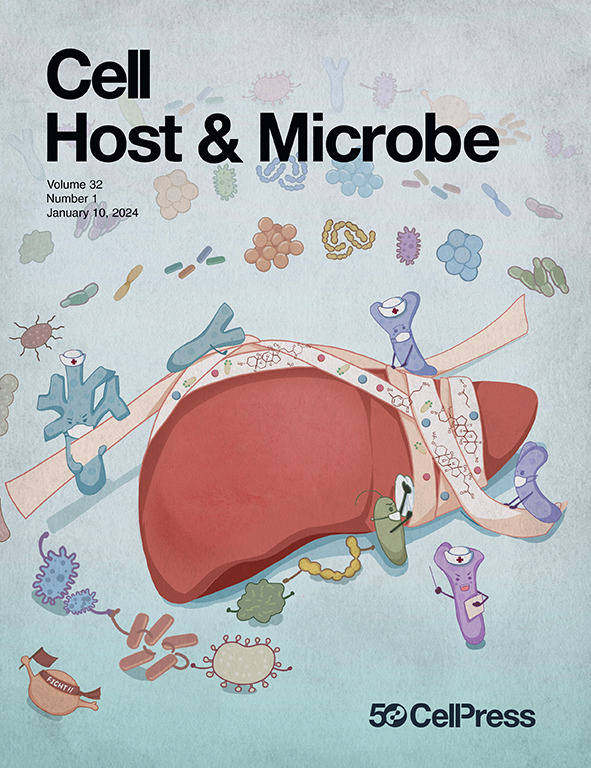Rhizosphere microbes mitigate the shade avoidance responses in Arabidopsis
IF 18.7
1区 医学
Q1 MICROBIOLOGY
引用次数: 0
Abstract
Shade avoidance responses are defined as the plastic responses of plants to neighboring shading signals through changes in the light spectrum, which limit planting density in modern agricultural practices. Here, we found that shade avoidance responses depend on soil microbes and identified a microbe-root-shoot circuit that bolsters aboveground shade tolerance in Arabidopsis thaliana. Rhizosphere microbes systemically regulate the expression of aboveground shade-responsive genes, which are associated with the altered homeostasis of jasmonic-acid- and salicylic-acid-related metabolites. We further found that the plasma-membrane-localized pattern recognition receptors FLS2/BAK1 and transcription factors MYC2/phytochrome-interacting factors (PIFs)/LONG HYPOCOTYL5 (HY5) are required for rhizosphere-microbe-alleviated shade avoidance. Our study characterized a signaling cascade (FLS2/BAK1-MYC2-PIF4/HY5) and provided a strategy for mitigating aboveground shade responses using rhizosphere microorganisms.

根际微生物减轻拟南芥避荫反应
遮荫回避响应是指植物通过光谱变化对邻近遮荫信号的塑性响应,这限制了现代农业实践中的种植密度。在这里,我们发现遮荫回避反应依赖于土壤微生物,并确定了一个微生物-根-芽回路,该回路增强了拟南芥的地上遮荫耐受性。根际微生物系统地调节地上遮荫响应基因的表达,这些基因与茉莉酸和水杨酸相关代谢物的稳态改变有关。我们进一步发现,质膜定位模式识别受体FLS2/BAK1和转录因子MYC2/光敏色素相互作用因子(pif)/长下cotyl5 (HY5)是根际微生物缓解避荫所必需的。我们的研究描述了一个信号级联(FLS2/BAK1-MYC2-PIF4/HY5),并提供了利用根际微生物减轻地上阴影反应的策略。
本文章由计算机程序翻译,如有差异,请以英文原文为准。
求助全文
约1分钟内获得全文
求助全文
来源期刊

Cell host & microbe
生物-微生物学
CiteScore
45.10
自引率
1.70%
发文量
201
审稿时长
4-8 weeks
期刊介绍:
Cell Host & Microbe is a scientific journal that was launched in March 2007. The journal aims to provide a platform for scientists to exchange ideas and concepts related to the study of microbes and their interaction with host organisms at a molecular, cellular, and immune level. It publishes novel findings on a wide range of microorganisms including bacteria, fungi, parasites, and viruses. The journal focuses on the interface between the microbe and its host, whether the host is a vertebrate, invertebrate, or plant, and whether the microbe is pathogenic, non-pathogenic, or commensal. The integrated study of microbes and their interactions with each other, their host, and the cellular environment they inhabit is a unifying theme of the journal. The published work in Cell Host & Microbe is expected to be of exceptional significance within its field and also of interest to researchers in other areas. In addition to primary research articles, the journal features expert analysis, commentary, and reviews on current topics of interest in the field.
 求助内容:
求助内容: 应助结果提醒方式:
应助结果提醒方式:


